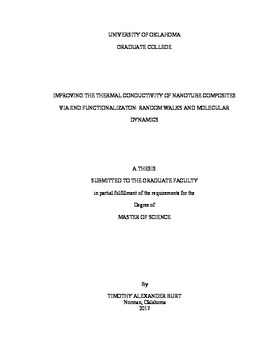| dc.contributor.advisor | Mullen, Kieran | |
| dc.contributor.author | Burt, Timothy | |
| dc.date.accessioned | 2017-12-12T21:10:05Z | |
| dc.date.available | 2017-12-12T21:10:05Z | |
| dc.date.issued | 2017-12 | |
| dc.identifier.uri | https://hdl.handle.net/11244/52763 | |
| dc.description.abstract | The high thermal conductivity of carbon nanotubes (CNTs) has promise for improving the thermal conductivity of nano composites. However, their large Kapitza resistance has frustrated this effect. One solution is to functionalize the ends of the CNT matching their vibration spectrum better to the surrounding medium. In this thesis we simulate cases in which the CNT ends are either well coupled or not well coupled to the surrounding medium. Our findings indicate a notable improvement of the thermal conductivity of functionalized CNTs versus pristine CNTs. The effects of excluded volume or sterics on the thermal conductivity is also examined. The necessary mathematics and physics are given along the way, as well as intuitive examples to make the concepts easier to understand. A random walk method is used to calculate the thermal conductivity of end-functionalized CNT composite materials, as well as molecular dynamics (MD) simulations that do the same. | en_US |
| dc.language | en_US | en_US |
| dc.subject | thermal | en_US |
| dc.subject | conductivity | en_US |
| dc.subject | nanotube | en_US |
| dc.subject | composites | en_US |
| dc.title | Improving the thermal conductivity of nanotube composites via end functionalization: random walks and molecular dynamics | en_US |
| dc.contributor.committeeMember | Glatzhofer, Daniel | |
| dc.contributor.committeeMember | Wang, Bin | |
| dc.date.manuscript | 2017-12 | |
| dc.thesis.degree | Master of Science | en_US |
| ou.group | College of Engineering::Department of Engineering Physics | en_US |
| shareok.orcid | 0000-0002-0616-8328 | en_US |
